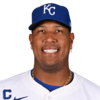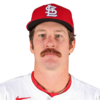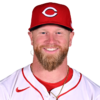
The conceit here is that I happen upon certain players far more than others by virtue of the way my builds come together.
But I've found that's not so much the case this year. I've done a fine job of diversifying, without even going out of my way to do so. Between the 11 teams I've already put together (and these are for true leagues, not just mocks) only three players are represented more than three times. And it's an eclectic group: Trey Mancini (five times), Miguel Vargas (four) and Elvis Andrus (four).
Vargas I get. On the Valentine's Day episode of the Fantasy Baseball Today podcast, he was my choice for player I love (more on him in a bit). But Mancini and Andrus? I guess I did include the former in my Sleepers 2.0 and the latter in my 40 Deep Sleepers, but they're not major investments that I'm staking my season to. They're just common choices to round out my roster in deeper 15-team Rotisserie leagues.
I feel like I've already talked about them to the extent that I need to. What I'd rather do here is identify some common draft targets of mine that I haven't had as much reason to discuss yet, whether in the two articles already mentioned or in Breakouts 2.0 or Most Underrated by ADP (it's that last one that I seem to draft from the most).
Give you something new heading into the biggest draft weekend, in other words. I won't claim there are zero duplicates between this article and those others, but in the cases where I do double up, you can trust that I'm really into that player.
(The numbers next to each player's picture represent his ADP according to two different sources.)
So I've settled on Juan Soto as the true No. 6 behind the obvious top five in categories leagues (Aaron Judge, Jose Ramirez, Ronald Acuna, Julio Rodriguez and Trea Turner) and ahead of any other outfielder I might consider taking in that spot (namely, Yordan Alvarez, Kyle Tucker or Mookie Betts). This means that if I'm drafting anywhere from six through nine, I have a reasonable chance of getting him, and well, it's happened a few times. I hold to this position even with his recent oblique tweak, by the way. Prior to it, Soto was saying he's finally righted the mechanics that were wrong all of last season, and indeed, he's brought the hammer to both the World Baseball Classic and the Cactus League.
Those who've followed my work closely this spring know I'm inclined to wait on first base, targeting scarcer positions like outfield and third base early. So how have I wound up with multiple shares of Paul Goldschmidt? My experience when picking at the end of Round 2 is that all the stud third basemen are already gone, Nolan Arenado included, and well, I still have to pick someone. Meanwhile, I targeted Goldschmidt specifically in our Head-to-Head points salary cap draft, where I was of course free to bid on anyone without being confined by turn order. He and Freddie Freeman were far and away the best first basemen in that format last year, and while everyone knows to spend big on Freeman, Goldschmidt tends to be a relative bargain.
The aforementioned Arenado is of course who I'd rather get late in Round 2 than Goldschmidt, with the presumption that Jose Ramirez (duh), Manny Machado, Rafael Devers, Austin Riley and Bobby Witt are already off the board. Arenado's Roto ADP is actually lower than where I target him, but I'm not willing to skip out on that large but very costly tier of third basemen. Anyone halfway decent after that is almost certain to be a much bigger reach. I'm not sure it even matters who else is available Round 2. If Arenado is there (and I didn't already take Ramirez in Round 1), he's mine.
Certain players stand out as singularities, capable of doing things no one else at their position can do, and I typically gravitate toward those players. Corey Seager, for instance, is the shortstop most likely to deliver both a .300 batting average and 30-plus homers. Trea Turner, Fernando Tatis and Bo Bichette have other contributions they make, but they're less likely than Seager to meet those two specific thresholds, and they come at a much higher cost. Seager's own cost keeps creeping up, such that I can no longer count on getting him in Round 5, but once Francisco Lindor is off the board, I'm on it.
Speaking of singularities, Salvador Perez is a notable one at the catcher position. Yes, I'm onto him again even after he burned me as my most-coveted player last year, but notably, the cost is much lower this time around. What crushed Perez last year were his attempts to play through a torn thumb ligament. His 162-game pace in the 57 games after returning from surgery came out to 34 homers and 119 RBI, along with the exit velocity readings to back it up. He remains the best bet to lead his position in home runs and the only catcher with a realistic shot at 100 RBI. I should note that my interest in him is higher in categories leagues than in points leagues.
In the crews I run with (i.e., other Fantasy Baseball analysts), the Corbin Carroll fervor has escalated to a point where I can no longer count on drafting him after Pick 50, and yet I find myself more attracted to him than ever. The way I put it in Breakouts 2.0 is that his best-case outcome is also a relatively high-probability outcome, and that best-case-slash-high-probability outcome would make him a stud. I'm not talking about a Round 4 stud either. I'm talking, like, Trea Turner. On just the stolen bases and runs scored, without any presumption of power, Carroll should live up to a Round 4 price tag, and so that's where I like to target him if Kyle Schwarber (see below) and Seager are already gone.
It helped that Nestor Cortes' start to spring training was delayed by a hamstring injury, which I think made certain people all the more squeamish about drafting him. Mostly, though, his numbers just seem too good to be true for someone with such an underwhelming arsenal. So why do I like him? Not only is he a master of deception and expert strike-thrower, but he also puts the ball in the air a ton, which actually works to his advantage in a post-juiced ball league. Fly balls that aren't home runs are generally outs, and so as long as the quality of contact remains low, Cortes should be able to sustain the disparity between his ERA (2.44) and xFIP (3.63).
I don't have a particular fondness for Kenley Jansen, but I do think he's one of just eight relievers who I can pencil in for 30 saves (Emmanuel Clase, Josh Hader, Devin Williams, Jordan Romano, Ryan Pressly, Raisel Iglesias and Felix Bautista being the others). Among them, Jansen tends to go last -- and sometimes by more than a round. I hate paying for saves, but I understand the necessity with so few dedicated closers these days. Jansen allows me to push the envelope just a bit. Fantasy Baseballers have been predicting his demise for five years running, it seems like, but he just keeps chugging along.
It's time for everyone's favorite game, Player A vs. Player B. You ready? Player A hit .240 with 34 homers, 103 RBI and 86 runs scored last year. Player B hit .242 with 36 homers, 94 RBI and 84 runs scored. Sounds about even, right? Well, Player A was Matt Olson, and Player B was Christian Walker, who's being drafted 70 picks later on average. I understand Olson has more upside and is far more proven than Walker, but when I'm loading up on scarcer positions early, it's precisely because I know comps like this exist at first base. Judging by the Statcast metrics, last year's numbers are well within Walker's capabilities.
Chris Sale seems every bit like this year's version of Justin Verlander to me. By that, I mean a Hall of Fame-caliber pitcher coming off the sort of long-term absence that causes us to lose sight of how good he is. But remember, in Sale's case, we got a little reminder when he returned from Tommy John surgery late in 2021. It's only the freak injuries (non-pitching-related) from a year ago that have caused everyone to forget. I don't know why more people don't see it, but as someone who purposely neglects starting pitcher early, I'm happy to take advantage. In fact, I recently moved Sale into my top 30 at the position just so I can take advantage over and over again.
We already know Joe Ryan to be an efficient strike-thrower whose fastball plays well above its velocity, which makes him a WHIP specialist and quality start machine without sacrificing too much in the strikeout department. As floors go, that's a pretty good one. But see, he established those baselines as a rookie last year, and already this spring, he's showing signs of finding another gear with a new sweeping slider and a new split-change. If he can build a secondary arsenal around that bonkers fastball, the sky's the limit. He seems like a high-floor, high-ceiling play and a perfect No. 4 for my thrifty starting pitcher builds.
As with Jansen, Daniel Bard isn't a closer that I deliberately target, but among those with a declared role and reasonable chance for 30 saves, he's the one nobody seems to want -- the last of a tier, basically, which is often a good source of value. I, too, can see the potential pitfalls for a 37-year-old with a spotty track record who pitches half his games at Coors Field, but David Bednar and Alexis Diaz aren't the most battle-tested either. Bard was clearly the most valuable of them last year, delivering 34 saves with a 1.79 ERA, 0.99 WHIP and 10.3 K/9, and if I can wait another couple rounds to draft him, I'm all for it.
Interestingly, the only place I've featured Brandon Drury so far is in Busts 2.0, but in there, I acknowledge that he may become worth drafting if his downfall is too widely presumed. That's precisely the case in Fantasy Baseball analyst circles, where he often slips into the 250 range. Sure, he was only good at Great American Ballpark last year, and there's no place else quite like it, but Angel Stadium is a fine place to hit, too. He'll have a bunch of on-base freaks ahead of him in that lineup, and you can already slot him at second or third base, with shortstop and outfield potentially to come. Even just 80 percent of last year's power production would make him a real asset.
Miguel Vargas' ADP has climbed into the top 200 in more recent weeks, with him back to swinging a bat in spring training games, but man, it was fun to draft him when his fractured pinky still had people on edge. These days, I'm willing to take him as early as Pick 150 to make sure I get him. Yeah, he's a rookie, but I expect him to be good at, well, everything -- most confidently batting average, but with enough power and speed to matter. Meanwhile, he'll be in a great lineup and will soon add second base eligibility, with third base and outfield being possibilities later. Even in points leagues, his plate discipline should be enough to set him apart.
I wasn't all that interested in Lance McCullers before he came down with a forearm strain, but with that news, his stock has taken such a tumble that I've been able to get him with my last pick or two. It doesn't even sound like that bad of an injury. He's already back on a throwing program and says doctors were hesitant to call the injury a strain, like it didn't even meet the criteria for Grade 1. His declining stock is an overreaction, perhaps understandably given his history, but when healthy, he's still a big bat-misser for a big winner. I'll happily stash him away in an IL spot if the cost is next to nothing.
Every time I snatch up Anthony Volpe, I picture Jesse Pinkman saying "he can't keep getting away with it." I don't know how his ADP isn't soaring to untenable levels with all the momentum he's gained this spring. He's still lasting beyond Pick 200 in most every league. It may be no better than a 50/50 shot he beats out Oswald Peraza for the starting shortstop job, but if it's announced tomorrow, he's probably pushing the top 100, much like Jordan Walker. As with any 21-year-old rookie, there are no guarantees, but Volpe offers a 20-homer, 40-steal profile with the sort of on-base skills that would make him a run-scoring machine batting at or near the top of the lineup.
Others I'm heavily invested in
For more on these players, see my Sleepers 2.0, Breakouts 2.0 or Underrated by ADP.
![[object Object] Logo](https://sportshub.cbsistatic.com/i/2020/04/22/e9ceb731-8b3f-4c60-98fe-090ab66a2997/screen-shot-2020-04-22-at-11-04-56-am.png)
























































